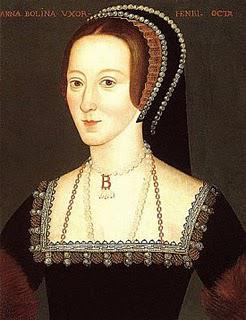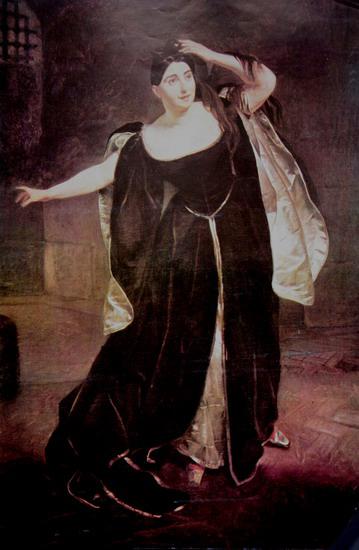
Anne Boleyn: 16th century portrait
Anne Boleyn has proved as fascinating to posterity as she was to Henry VIII. Scholars and dilettantes, poets and painters, have been fascinated by the second of the (in)famous English king's wives, the first to be executed... and that after accusations of plotting regicide, and committing adultery with no fewer than five men, including her own brother. The subject is temptingly sensational, as a glance at a list of fictional works concerning the unfortunate queen demonstrates. The debates are virtually inexhaustible: how credible did the charges against her have to be? were they only a means to a desired end? desired by whom? I won't pretend to answer all these questions, but in honor of the 1 month countdown to the Met Opera's season opening performance of Donizetti's opera (I'm excited!) I present a brief summary of Anne's political and posthumous career.Among the many historical inaccuracies of Donizetti's thoroughly Romantic opera, perhaps the most striking is the unanimous sympathy expressed by the chorus of courtiers for the queen herself. In actual fact, the factionalism of Henry's court was lively, bitter, and, in some scholarly interpretations, the chief cause of Anne Boleyn's downfall and eventual death. During the years of Anne's favor with the king (longer than their marriage) members of her family and their allies were granted influential positions; such influence attracted envy, and in the years of Anne's uneasy position as Henry's mistress, it would be all too easy to claim that the king's judgment had been led astray by his passion. Even after her marriage and accession to the throne, even after the death of Katherine of Aragon, there were those who persistently referred to her as "the Concubine." What of Anne herself? Much ink, scholarly and otherwise, has been spilled in attempting to analyze her character and her motives. I personally find her more credible as player than pawn. In fictional accounts of her story, naturally enough, legal innocence has been equated with good character, the definition of which is, of course, relative. Modern novelists have read between the lines of her story to find a vivacious heroine whose attempts at self-expression and self-assertion brought her downfall. For the Romantic movement which influenced Donizetti, however, she was a heroine of a very different sort.

Giuditta Pasta as Anna
Donizetti eagerly embraced the inspiration of the Romantic movement. The novels of Sir Walter Scott inspired works such as Rossini's La Donna del Lago (1819), and Donizetti's own Il Castello di Kenilworth (1821.) Bellini's Il Pirata (1827) emphasized darker elements of the genre, a tendency also visible in the violence of Anna Bolena, much of which is sexually motivated. William Ashbrook has described the relationships between the characters in the drama as expressed in a series of overlapping triangles: wife-husband-lover, wife-husband-mistress, wife-husband-page. Anna, although married to Henrico, pines for Percy, her first love, who still harbors passion for her. Henrico has seduced Giovanna Seymour, whose remorse, and affection for Anna, are insufficient to quell her feelings for the king. Meanwhile, the adoration of the page Smeton for the isolated queen sparks the volatile Henrico's jealousy.The critic Mazzini called Anna Bolena "epic poetry in music." The libretto, by Felice Romani, is available in a lovely Ricordi edition with proper line breaks and without a clumsy English translation to clutter it up (Amazon; I got mine more cheaply at the Met Shop, but it isn't listed through their online outlet.) From its premiere onwards, critics have seen in it signs of artistic meticulousness and individual imagination lacking in Donizetti's earlier oeuvre. Philip Gossett, however, has argued that Anna Bolena represents rather a demonstration of the composer's developing craft, and evolving artistic sensibilities, than a sudden break with his previous output. According to Gossett (in this book,) "Many of Donizetti's changes in the autograph of Anna Bolena reveal his tendency to give proportion and balance lower priority than directness of utterance, avoidance of formal repetition, and... dramatic continuity."
These changes mark experimentation with, rather than a rejection of, the forms which defined Rossini's mature work, and therewith much of Donizetti's musical world. But Donizetti's own individuality as an artist, and the individuality of his characters, are strongly apparent. In duets, arioso passages, and cabalettas, seemingly endless permutations of confrontations occur. The mercurial monarch, the smitten page, the timid but passionate lady-in-waiting, the fiery young nobleman; they all revolve around the ambitious woman who sees too late that she has lost a chance at love. Nor do Donizetti and Romani resolve the enigmas of Anna's character: in her tempestuous final scene, she may speak words of forgiveness, but the fierce music tells another, and equally compelling story. Anna Netrebko brings it to the Met in the fall.

